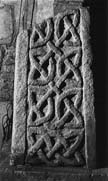Select a site alphabetically from the choices shown in the box below. Alternatively, browse sculptural examples using the Forward/Back buttons.
Chapters for this volume, along with copies of original in-text images, are available here.
Object type: Part of cross-shaft
Measurements: L. 75 cm (29.5 in) W. 42 > 36 cm (16.5 > 14.2 in) D. 25 > 20 cm (9.8 > 7.9 in)
Stone type: Yellowish grey (10YR 8/2) shelly oolitic limestone, with ooliths from 0.3mm (in ground mass) up to 0.6mm diameter, together with pellets, in a prominent hard calcite matrix; shell fragments are aligned parallel to the front face as carved. Barnack Rag type, Upper Lincolnshire Limestone, Inferior Oolite Group
Plate numbers in printed volume: Ills. 94–8
Corpus volume reference: Vol 5 p. 130-131
(There may be more views or larger images available for this item. Click on the thumbnail image to view.)
A fragment from the middle of a flat, slightly tapering grave-cover of Lindsey type decorated in low relief and only on the upper surface.
A (top): The border is defined by a twin cable moulding in a herringbone pattern, and the central panel is occupied by three interconnecting lines of simple pattern F interlace, which produce a repetitive figure-of-eight pattern in four incomplete rows. The figure-of-eight units measure 18 × 11.5 cm (7 × 4.5 in): the layout and spacing of the lines and rows is competently regular. The decoration stands sharply as a squared U section against the flat cut-away background in a manner typical of the cover type.
B and D (long): Undecorated, but worked into a bowed section.
C and E (ends): Broken.
F (bottom): Roughly dressed and with a regular rebate of rectangular section cut in secondary use.
This shaft has several of the key characteristics associated with the South Kesteven shaft group (Chapter V). It is made of the characteristic shelly ragstone, it is thin relative to its width, and it has distinctive undecorated borders of rectangular section. The decoration on all four faces is also characteristic. Runs of three- and four-strand plait of similar character to this are found on many of the pieces assigned to this group, and the debased vine-scroll on face C finds a very close parallel with that on Creeton 1, which also has a 'bud' of exactly the same stylised type (Ill. 124). This type of debased vine-scroll is widely distributed in Cumbria, Northumbria, Yorkshire and Derbyshire, but is less common further south, although it occurs elsewhere within the South Kesteven shaft group, for example at Peterborough Cathedral. The interlace pattern on face A is also found on Creeton 1 (Ill. 126) and at Stoke Rochford (Ill. 348). Fox commented on this pattern (1920–1, 39) and he compared it with that decorating the shaft at Whissonsett, Norfolk. However, Fox was informed by Rev. Davies that this shaft originally supported the Colsterworth cross-head (no. 2 below) – a proposition not accepted here as it is clearly of a quite different stone type. This erroneous reconstruction of the Colsterworth shaft with a similar cross-head to that at Whissonsett coloured Fox's analysis of this monument, but, even so, Fox was right to draw a close parallel between the South Kesteven shafts and the group he had identified round the southern and eastern borders of the Fenland, and the close similarities between the two groups of monuments is considered above. We do not believe, with Fox, however, that Colsterworth 1 should be dated by reference to Whissonsett to the early tenth century. It is suggested above that the date bracket for this whole group of shafts does not open until the mid tenth century and that many examples must belong to the first half of the eleventh century. There may be grounds for placing Colsterworth 1 early on within the South Kesteven group, however: it is relatively well cut (and the interlace pattern on face A follows one of the most competent layouts in the group). The presence of the debased vine-scroll may also suggest an earlier date than those shafts which have only interlace.



